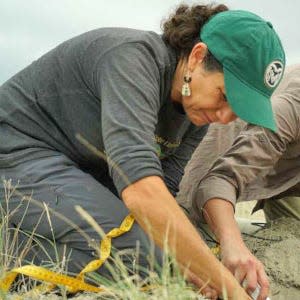Colorado soil ecologist to help lead new research project

Organic matter makes up only a small portion of soil, usually between one and ten percent, but it’s essential for nutrient cycling, aggregate structure and water infiltration and retention, all key attributes of soil health, according to Francesca Cotrufo, a professor of soil and crop sciences at Colorado State University.
The university announced this week that Cotrufo has been tapped to assist in leading a $19 million international research project aimed at understanding how grazing management decisions impact soil health and, in turn, how soil health can positively impact a producer’s own well-being.
The project, titled Metrics, Management, and Monitoring: An Investigation of Pasture and Rangeland Soil Health and its Drivers, was announced during the National Grazing Lands Coalition tri-annual meeting. The largest portion of the funding will come from a Foundation for Food and Ag Research grant, combined with another large contribution from the Noble Research Institute, based in Oklahoma. Additional financial contributions will come from Greenacres Foundation, Jones Family Foundation and ButcherBox.
Cotrufo will serve as a co-leader along with researchers at the Noble Research Institute, Michigan State University and multiple international partners. Other CSU faculty collaborators involved with the project include Keith Paustian, a professor of soil and crop sciences, Dale Manning, associate professor in the department of agricultural and resource economics, and Megan Machmuller, research scientist in soil and crop sciences.
All are members of CSU’s Soil Carbon Solutions Center, which was formed earlier this year to serve as a multidisciplinary central clearinghouse for climate-focused soil science across the university.
Cotrufo’s specific expertise is in soil ecology and biogeochemistry, which factors heavily into the dynamics of soil carbon sequestration.
This fall she was invited to present the prestigious Leu Lecture at the University of Nebraska’s Center for Grassland Studies. Beforehand, she was invited to talk about her work on the center’s podcast.
One main focus, she explained, is to better understand the different components within soil organic matter and how they respond to changes in the atmosphere.
Her particular specialization studies the component of organic matter associated with chemical bonding to minerals. This subset of organic matter deteriorates more slowly and persists longer than some other soil components, but the others are also necessary for breaking down carbon more rapidly and making nutrients available to plants.
“Not all soil organic matter is made equal,” she said. “Different components react in different ways, and if we look at it as one thing, we might miss how global changes will affect it.”
Ultimately the goal is to develop a basic understanding of organic matter properties so that grazing management can be adjusted in ways that enhance soil fertility and productivity and optimize carbon sequestration.
Cotrufo and her colleagues have long argued that enhancing the health of soils requires a more nuanced approach than simply stuffing as much carbon back into the ground as possible.
Plant biomass is essential to regenerating soil organic matter, she maintains. But organic matter deposition also benefits from a diversity of biomass, including legumes that fix nitrogen and plants that are shallower or deeper rooting.
Two things to limit are bare fallowing periods and soil disturbance through tillage, which breaks up aggregate structures in negative ways.
“You want to keep the soil microbes fed throughout the year,” she said.
Listening to farmers, their needs and challenges, will be critical if researchers want to move forward with broad-scale adoption of new practices, she noted, adding that bringing farmers on board with the soil health movement would be necessary for any serious large-scale regeneration of landscapes.
Cotrufo advocates for the use of modern communication tools to create outreach to farmers, but also to the general public. New discoveries in science should be shared broadly, and discussion formats used to bring students, farmers and the public into a conversation about what can be done to create a healthier environment, she said.
“The humans are part of the problem, but they also have to be part of the solution,” she said. “We can’t have solutions without human acceptance.”
The newly announced research project, involving more than a dozen different public and private entities, will help bring together decades of research on the fundamentals of soil carbon sequestration, she said.
It is also intended to increase the value of soil health measurements, reduce labor and cost involved in taking those measurements, and facilitate a more comprehensive understanding of soil health that goes beyond single site evaluations.
“By bridging the bio-physics and socio-economics of grazing systems and partnering with farmers and ranchers, our project will provide real solutions for accurately monitoring and enhancing the health of soils,” Cotrufo said.
This article originally appeared on LA Junta Tribune: Colorado soil ecologist to help lead new research project
